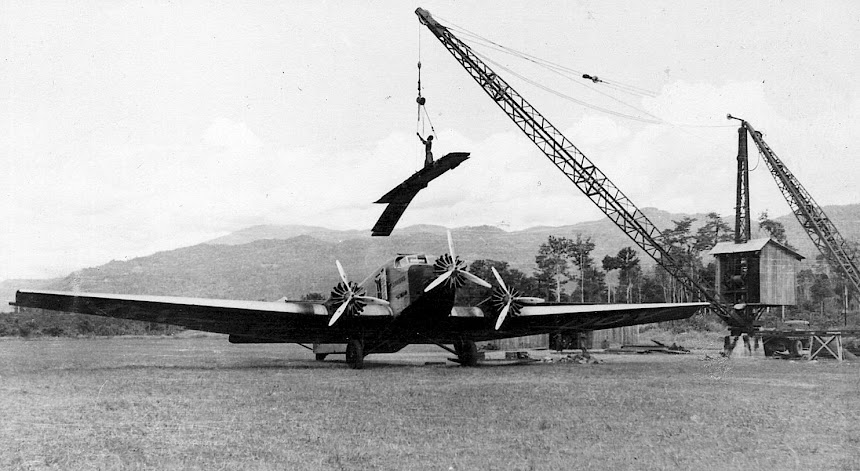Apart from gold, there is something else that iconic Bulolo, Morobe province, is famous for, and that is its beautiful and majestic pine trees.
 |
| Plantation pine at Bulolo. Picture courtesy of PNG FOREST PRODUCTS |
The plantations are run by the National Forest Service of the PNG Forest Authority with the major client being PNG Forest Products, a company that evolved from Bulolo Gold Dredging Ltd, which commenced operations in large-scale alluvial mining in the late 1920s.
But beneath the surface is a festering sore which must be attended to and that is the issue of traditional ownership of the land on which the pine plantations stand.
Skeletons of the past are now emerging from the magnificent pine forests of Bulolo.
 |
| Golden Pine Plantations, Bulolo. Picture by PNG FOREST PRODUCTS |
It has shades of the infamous Manhattan island purchase of 1626, in which that prime piece of real estate now worth billions, was purchased from American Indians for a measly $24 worth of trinkets!
To understand how the forestry business began in Bulolo, it is necessary to step back in time, to the late 1920s when it was one of the largest gold fields in the world.
A total of seven dredges scoured the valley floor, dredging thousands of tonnes of high grade gold-bearing ore.
As the mining operation scaled down, the plywood factory and sawmill were constructed.
In collaboration with the then government, the pine plantations were also established at this time.
In 1954, plywood production and the export of product to overseas destinations commenced.
From the early 1950s the company has been involved in the conversion of both hardwood and plantation resource to high value end products.
Today, PNG Forest Products is the leading producer of timber and plywood products using only 100% plantation pine.
Its products include prefabricated houses, dressed timber and mouldings, treated power poles, export high grade plywood and veneers.
Australian administration of the then Territory of New Guinea, in 1948 and 1951, acquired the land on which large forests of hoop and klinkii pine are now situated from landowners at Manki village.
Copies of original land transfer documents obtained by The National show that that Australian administration paid a mere 583 pounds in 1948 and 5, 705 pounds in 1951 for land and forest assets now worth millions.
The landowners, however, argue that they have never seen or received any of this money
In 1952, BGD and the Australian government became partners in a company called Commonwealth New Guinea Timbers (CNGT), which has evolved into today’s PNGFP under different ownership.
The plan was to make plywood from the hoop and klinki pines on Manki land, which resulted in what landowners term the “unlawful” acquisition of native land by the Australian administration.
The Wenge Tanataime Landowners’ Association from Wautu local level government (LLG) in Bulolo, the legal body set up by landowners of Manki village, has been arguing with the PNG government over the last couple of years in relation to the 1948 and 1951 land purchases issue.
They have written to Prime Minister Sir Michael Somare, acting chief secretary Manasupe Zurenuoc, PNGFA and the Lands Titles Commission (LTC), among others, to spell out their grievances.
The PNGFA, the only one to respond so far, has advised the landowners to pursue their claim through the LTC, and failing that, through the courts.
“We say this because PNG Forest Authority, as a state agency, occupies the Bulolo plantation land through a certificate of occupancy,” PNGFA legal officer Uti Sepoe said in a letter to landowners last November.
“Any closure of the plantation by your association will invoke the full force of the law.PNG Forest Authority does not wish this to happen.”
The association says the legislation governing the ‘transfer of land by natives to the administration’ during the colonial era was the Land Ordinance 1922, which stated that land may be acquired in the territory for purposes other than mining or forestry under a lease hold tenure granted by the administration in accordance with the 1922 ordinance.
The type of leases provided for were agricultural purposes, pastoral purposes, residences and business purposes, special purposes and mission leases.
“Therefore, the acquisition/purchase/transfer of Manki native land under the land ordinance is legally questionable,” the association argues.
“A legal opinion exists that purchase of native land for mining or forestry is not permitted under the land ordinance.
“The condition under which land may be taken for the purpose of felling, cutting removing and disposing of timber are set forth in the Forestry Ordinance 1936.
“That is if the native owners are willing to dispose the timber growing on any land, then the administration may acquire the exclusive right to such timber.
“In addition to the forestry ordinance, there was a special piece of legislation entitled ‘New Guinea Timber Agreement Act 1952’, which was enacted by the Australian parliament.
“This covered the agreement between the commonwealth of Australia and BGD to form a company, CNGT, with the object of acquiring timber rights in the territory.”
Landowners’ consultant, Kevin Mon, was in Port Moresby recently to follow up on letters sent last year; however, most of them, apart from NFA, didn’t seem to give a hoot.
“I have delivered documents outlining our claims to Bulolo MP Sam Basil and Morobe administrator Kemas Tomala,” he said from Bulolo.
“Up to now, we are still waiting for a reply from them.”

No comments:
Post a Comment